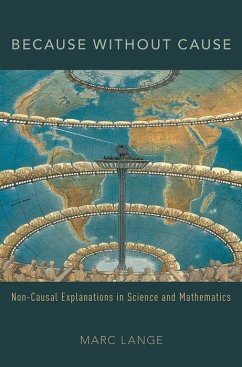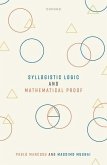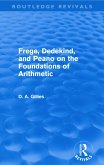Marc Lange (Chair of the Philos Chair of the Philosophy Department
Because Without Cause
Non-Causal Explanations in Science and Mathematics
Marc Lange (Chair of the Philos Chair of the Philosophy Department
Because Without Cause
Non-Causal Explanations in Science and Mathematics
- Gebundenes Buch
- Merkliste
- Auf die Merkliste
- Bewerten Bewerten
- Teilen
- Produkt teilen
- Produkterinnerung
- Produkterinnerung
Not all scientific explanations work by describing causal connections between events or the world's overall causal structure. In addition, mathematicians regard some proofs as explaining why the theorems being proved do in fact hold. This book proposes new philosophical accounts of many kinds of non-causal explanations in science and mathematics.
Andere Kunden interessierten sich auch für
![Because Without Cause Because Without Cause]() Marc Lange (Chair of the Philos Chair of the Philosophy DepartmentBecause Without Cause58,99 €
Marc Lange (Chair of the Philos Chair of the Philosophy DepartmentBecause Without Cause58,99 €![Syllogistic Logic and Mathematical Proof Syllogistic Logic and Mathematical Proof]() Prof Paolo Mancosu (Berkeley University of California)Syllogistic Logic and Mathematical Proof96,99 €
Prof Paolo Mancosu (Berkeley University of California)Syllogistic Logic and Mathematical Proof96,99 €![Frege, Dedekind, and Peano on the Foundations of Arithmetic (Routledge Revivals) Frege, Dedekind, and Peano on the Foundations of Arithmetic (Routledge Revivals)]() Donald GilliesFrege, Dedekind, and Peano on the Foundations of Arithmetic (Routledge Revivals)83,99 €
Donald GilliesFrege, Dedekind, and Peano on the Foundations of Arithmetic (Routledge Revivals)83,99 €![Hilbert's Programs and Beyond Hilbert's Programs and Beyond]() Wilfried SiegHilbert's Programs and Beyond69,99 €
Wilfried SiegHilbert's Programs and Beyond69,99 €![Proofs and Refutations Proofs and Refutations]() Imre LakatosProofs and Refutations29,99 €
Imre LakatosProofs and Refutations29,99 €![An Illustrated Book of Bad Arguments An Illustrated Book of Bad Arguments]() Ali AlmossawiAn Illustrated Book of Bad Arguments16,99 €
Ali AlmossawiAn Illustrated Book of Bad Arguments16,99 €![Beyond Infinity Beyond Infinity]() Eugenia ChengBeyond Infinity10,99 €
Eugenia ChengBeyond Infinity10,99 €-
-
-
Not all scientific explanations work by describing causal connections between events or the world's overall causal structure. In addition, mathematicians regard some proofs as explaining why the theorems being proved do in fact hold. This book proposes new philosophical accounts of many kinds of non-causal explanations in science and mathematics.
Hinweis: Dieser Artikel kann nur an eine deutsche Lieferadresse ausgeliefert werden.
Hinweis: Dieser Artikel kann nur an eine deutsche Lieferadresse ausgeliefert werden.
Produktdetails
- Produktdetails
- Oxford Studies in Philosophy of Science
- Verlag: Oxford University Press Inc
- Seitenzahl: 512
- Erscheinungstermin: 16. November 2016
- Englisch
- Abmessung: 241mm x 163mm x 40mm
- Gewicht: 1008g
- ISBN-13: 9780190269487
- ISBN-10: 0190269480
- Artikelnr.: 47863267
- Herstellerkennzeichnung
- Libri GmbH
- Europaallee 1
- 36244 Bad Hersfeld
- gpsr@libri.de
- Oxford Studies in Philosophy of Science
- Verlag: Oxford University Press Inc
- Seitenzahl: 512
- Erscheinungstermin: 16. November 2016
- Englisch
- Abmessung: 241mm x 163mm x 40mm
- Gewicht: 1008g
- ISBN-13: 9780190269487
- ISBN-10: 0190269480
- Artikelnr.: 47863267
- Herstellerkennzeichnung
- Libri GmbH
- Europaallee 1
- 36244 Bad Hersfeld
- gpsr@libri.de
Marc Lange is a philosopher of science. He serves as Chair of the Philosophy Department at the University of North Carolina at Chapel Hill, where he is the Theda Perdue Distinguished Professor. His previous books include Laws and Lawmakers (OUP 2009), An Introduction to the Philosophy of Physics: Locality, Fields, Energy, and Mass (2002), and Natural Laws in Scientific Practice (OUP 2000).
* Table of Contents
* 0. Preface
* 0.1 Welcome
* 0.2 What this book is not about
* 0.3 Coming attractions
* Part 1: Scientific Explanations by Constraint
* 1. What Makes a Scientific Explanation Distinctively Mathematical?
* 1.1 Distinctively mathematical explanations in science as non-causal
scientific explanations
* 1.2 Are distinctively mathematical explanations set apart by their
failure to cite causes?
* 1.3 Mathematical explanations do not exploit causal powers
* 1.4 How these distinctively mathematical explanations work
* 1.5 Elaborating my account of distinctively mathematical explanations
* 1.6 Conclusion
* 2. "There Sweep Great General Principles Which All The Laws Seem To
Follow"
* 2.1 The task: to unpack the title of this chapter
* 2.2 Constraints versus coincidences
* 2.3 Hybrid explanations
* 2.4 Other possible kinds of constraints besides conservation laws
* 2.5 Constraints as modally more exalted than the force laws they
constrain
* 2.6 My account of the difference between constraints and coincidences
* 2.7 Accounts that rule out explanations by constraint
* 3. The Lorentz Transformations and the Structure of Explanations by
Constraint
* 3.1 Transformation laws as constraints or coincidences
* 3.2 The Lorentz transformations given an explanation by constraint
* 3.3 Principle versus constructive theories
* 3.4 How this non-causal explanation comes in handy
* 3.5 How explanations by constraint work
* 3.6 Supplying information about the source of a constraint's
necessity
* 3.7 What makes a constraint "explanatorily fundamental"?
* Appendix: A purely kinematical derivation of the Lorentz
transformations
* 4. The Parallelogram of Forces and the Autonomy of Statics
* 4.1 A forgotten controversy in the foundations of classical physics
* 4.2 The dynamical explanation of the parallelogram of forces
* 4.3 Duchayla's statical explanation
* 4.4 Poisson's statical explanation
* 4.5 Statical explanation under some familiar accounts of natural law
* 4.6 My account of what is at stake
* Part 2: Two Other Varieties of Non-Causal Explanation in Science
* 5. Really Statistical Explanations and Genetic Drift
* 5.1 Introduction to Part 2
* 5.2 RS (Really Statistical) explanations
* 5.3 Drift
* 6. Dimensional Explanations
* 6.1 A simple dimensional explanation
* 6.2 A more complicated dimensional explanation
* 6.3 Different features of a derivative law may receive different
dimensional explanations
* 6.4 Dimensional homogeneity
* 6.5 Independence from some other quantities as part of a dimensional
explanans
* Part 3. Explanation in Mathematics
* 7. Aspects of Mathematical Explanation: Symmetry, Salience, and
Simplicity
* 7.1 Introduction to proofs that explain why mathematical theorems
holds
* 7.2 Zeitz's biased coin: A suggestive example of mathematical
explanation
* 7.3 Explanation by symmetry
* 7.4 A theorem explained by a symmetry in the unit imaginary number
* 7.5 Geometric explanations that exploit symmetry
* 7.6 Generalizing the proposal
* 7.7 Conclusion
* 8. Mathematical Coincidences and Mathematical Explanations That Unify
* 8.1 What is a mathematical coincidence?
* 8.2 Can mathematical coincidence be understood without appealing to
mathematical explanation?
* 8.3 A mathematical coincidence's components have no common proof
* 8.4 A shift of context may change a proof's explanatory power
* 8.5 Comparison to other proposals
* 8.6 Conclusion
* 9 Desargues' Theorem as a Case Study of Mathematical Explanation,
Existence, and Natural Properties
* 9.1 Introduction
* 9.2 Three proofs - but only one explanation - of Desargues' theorem
in two-dimensional Euclidean geometry
* 9.3 Why Desargues' theorem in two-dimensional Euclidean geometry is
explained by an exit to the third dimension
* 9.4 Desargues' theorem in projective geometry: unification and
existence in mathematics
* 9.5 Desargues' theorem in projective geometry: explanation and
natural properties in mathematics
* 9.6 Explanation by subsumption under a theorem
* 9.7 Conclusion
* Part 4: Explanations in Mathematics and Non-Causal Scientific
Explanations -- Together
* 10 Mathematical Coincidence and Scientific Explanation
* 10.1 Physical coincidences that are no mathematical coincidence
* 10.2 Explanations from common mathematical form
* 10.3 Explanations from common dimensional architecture
* 10.4 Targeting new explananda
* 11 What Makes Some Reducible Physical Properties Explanatory?
* 11.1 Introduction
* 11.2 Centers of mass and reduced mass
* 11.3 Reducible properties on Strevens's account of scientific
explanation
* 11.4 Dimensionless quantities as explanatorily powerful reducible
properties
* 11.5 My proposal
* 11.6 Conclusion: all varieties of explanation as species of the same
genus
* References
* Index
* 0. Preface
* 0.1 Welcome
* 0.2 What this book is not about
* 0.3 Coming attractions
* Part 1: Scientific Explanations by Constraint
* 1. What Makes a Scientific Explanation Distinctively Mathematical?
* 1.1 Distinctively mathematical explanations in science as non-causal
scientific explanations
* 1.2 Are distinctively mathematical explanations set apart by their
failure to cite causes?
* 1.3 Mathematical explanations do not exploit causal powers
* 1.4 How these distinctively mathematical explanations work
* 1.5 Elaborating my account of distinctively mathematical explanations
* 1.6 Conclusion
* 2. "There Sweep Great General Principles Which All The Laws Seem To
Follow"
* 2.1 The task: to unpack the title of this chapter
* 2.2 Constraints versus coincidences
* 2.3 Hybrid explanations
* 2.4 Other possible kinds of constraints besides conservation laws
* 2.5 Constraints as modally more exalted than the force laws they
constrain
* 2.6 My account of the difference between constraints and coincidences
* 2.7 Accounts that rule out explanations by constraint
* 3. The Lorentz Transformations and the Structure of Explanations by
Constraint
* 3.1 Transformation laws as constraints or coincidences
* 3.2 The Lorentz transformations given an explanation by constraint
* 3.3 Principle versus constructive theories
* 3.4 How this non-causal explanation comes in handy
* 3.5 How explanations by constraint work
* 3.6 Supplying information about the source of a constraint's
necessity
* 3.7 What makes a constraint "explanatorily fundamental"?
* Appendix: A purely kinematical derivation of the Lorentz
transformations
* 4. The Parallelogram of Forces and the Autonomy of Statics
* 4.1 A forgotten controversy in the foundations of classical physics
* 4.2 The dynamical explanation of the parallelogram of forces
* 4.3 Duchayla's statical explanation
* 4.4 Poisson's statical explanation
* 4.5 Statical explanation under some familiar accounts of natural law
* 4.6 My account of what is at stake
* Part 2: Two Other Varieties of Non-Causal Explanation in Science
* 5. Really Statistical Explanations and Genetic Drift
* 5.1 Introduction to Part 2
* 5.2 RS (Really Statistical) explanations
* 5.3 Drift
* 6. Dimensional Explanations
* 6.1 A simple dimensional explanation
* 6.2 A more complicated dimensional explanation
* 6.3 Different features of a derivative law may receive different
dimensional explanations
* 6.4 Dimensional homogeneity
* 6.5 Independence from some other quantities as part of a dimensional
explanans
* Part 3. Explanation in Mathematics
* 7. Aspects of Mathematical Explanation: Symmetry, Salience, and
Simplicity
* 7.1 Introduction to proofs that explain why mathematical theorems
holds
* 7.2 Zeitz's biased coin: A suggestive example of mathematical
explanation
* 7.3 Explanation by symmetry
* 7.4 A theorem explained by a symmetry in the unit imaginary number
* 7.5 Geometric explanations that exploit symmetry
* 7.6 Generalizing the proposal
* 7.7 Conclusion
* 8. Mathematical Coincidences and Mathematical Explanations That Unify
* 8.1 What is a mathematical coincidence?
* 8.2 Can mathematical coincidence be understood without appealing to
mathematical explanation?
* 8.3 A mathematical coincidence's components have no common proof
* 8.4 A shift of context may change a proof's explanatory power
* 8.5 Comparison to other proposals
* 8.6 Conclusion
* 9 Desargues' Theorem as a Case Study of Mathematical Explanation,
Existence, and Natural Properties
* 9.1 Introduction
* 9.2 Three proofs - but only one explanation - of Desargues' theorem
in two-dimensional Euclidean geometry
* 9.3 Why Desargues' theorem in two-dimensional Euclidean geometry is
explained by an exit to the third dimension
* 9.4 Desargues' theorem in projective geometry: unification and
existence in mathematics
* 9.5 Desargues' theorem in projective geometry: explanation and
natural properties in mathematics
* 9.6 Explanation by subsumption under a theorem
* 9.7 Conclusion
* Part 4: Explanations in Mathematics and Non-Causal Scientific
Explanations -- Together
* 10 Mathematical Coincidence and Scientific Explanation
* 10.1 Physical coincidences that are no mathematical coincidence
* 10.2 Explanations from common mathematical form
* 10.3 Explanations from common dimensional architecture
* 10.4 Targeting new explananda
* 11 What Makes Some Reducible Physical Properties Explanatory?
* 11.1 Introduction
* 11.2 Centers of mass and reduced mass
* 11.3 Reducible properties on Strevens's account of scientific
explanation
* 11.4 Dimensionless quantities as explanatorily powerful reducible
properties
* 11.5 My proposal
* 11.6 Conclusion: all varieties of explanation as species of the same
genus
* References
* Index
* Table of Contents
* 0. Preface
* 0.1 Welcome
* 0.2 What this book is not about
* 0.3 Coming attractions
* Part 1: Scientific Explanations by Constraint
* 1. What Makes a Scientific Explanation Distinctively Mathematical?
* 1.1 Distinctively mathematical explanations in science as non-causal
scientific explanations
* 1.2 Are distinctively mathematical explanations set apart by their
failure to cite causes?
* 1.3 Mathematical explanations do not exploit causal powers
* 1.4 How these distinctively mathematical explanations work
* 1.5 Elaborating my account of distinctively mathematical explanations
* 1.6 Conclusion
* 2. "There Sweep Great General Principles Which All The Laws Seem To
Follow"
* 2.1 The task: to unpack the title of this chapter
* 2.2 Constraints versus coincidences
* 2.3 Hybrid explanations
* 2.4 Other possible kinds of constraints besides conservation laws
* 2.5 Constraints as modally more exalted than the force laws they
constrain
* 2.6 My account of the difference between constraints and coincidences
* 2.7 Accounts that rule out explanations by constraint
* 3. The Lorentz Transformations and the Structure of Explanations by
Constraint
* 3.1 Transformation laws as constraints or coincidences
* 3.2 The Lorentz transformations given an explanation by constraint
* 3.3 Principle versus constructive theories
* 3.4 How this non-causal explanation comes in handy
* 3.5 How explanations by constraint work
* 3.6 Supplying information about the source of a constraint's
necessity
* 3.7 What makes a constraint "explanatorily fundamental"?
* Appendix: A purely kinematical derivation of the Lorentz
transformations
* 4. The Parallelogram of Forces and the Autonomy of Statics
* 4.1 A forgotten controversy in the foundations of classical physics
* 4.2 The dynamical explanation of the parallelogram of forces
* 4.3 Duchayla's statical explanation
* 4.4 Poisson's statical explanation
* 4.5 Statical explanation under some familiar accounts of natural law
* 4.6 My account of what is at stake
* Part 2: Two Other Varieties of Non-Causal Explanation in Science
* 5. Really Statistical Explanations and Genetic Drift
* 5.1 Introduction to Part 2
* 5.2 RS (Really Statistical) explanations
* 5.3 Drift
* 6. Dimensional Explanations
* 6.1 A simple dimensional explanation
* 6.2 A more complicated dimensional explanation
* 6.3 Different features of a derivative law may receive different
dimensional explanations
* 6.4 Dimensional homogeneity
* 6.5 Independence from some other quantities as part of a dimensional
explanans
* Part 3. Explanation in Mathematics
* 7. Aspects of Mathematical Explanation: Symmetry, Salience, and
Simplicity
* 7.1 Introduction to proofs that explain why mathematical theorems
holds
* 7.2 Zeitz's biased coin: A suggestive example of mathematical
explanation
* 7.3 Explanation by symmetry
* 7.4 A theorem explained by a symmetry in the unit imaginary number
* 7.5 Geometric explanations that exploit symmetry
* 7.6 Generalizing the proposal
* 7.7 Conclusion
* 8. Mathematical Coincidences and Mathematical Explanations That Unify
* 8.1 What is a mathematical coincidence?
* 8.2 Can mathematical coincidence be understood without appealing to
mathematical explanation?
* 8.3 A mathematical coincidence's components have no common proof
* 8.4 A shift of context may change a proof's explanatory power
* 8.5 Comparison to other proposals
* 8.6 Conclusion
* 9 Desargues' Theorem as a Case Study of Mathematical Explanation,
Existence, and Natural Properties
* 9.1 Introduction
* 9.2 Three proofs - but only one explanation - of Desargues' theorem
in two-dimensional Euclidean geometry
* 9.3 Why Desargues' theorem in two-dimensional Euclidean geometry is
explained by an exit to the third dimension
* 9.4 Desargues' theorem in projective geometry: unification and
existence in mathematics
* 9.5 Desargues' theorem in projective geometry: explanation and
natural properties in mathematics
* 9.6 Explanation by subsumption under a theorem
* 9.7 Conclusion
* Part 4: Explanations in Mathematics and Non-Causal Scientific
Explanations -- Together
* 10 Mathematical Coincidence and Scientific Explanation
* 10.1 Physical coincidences that are no mathematical coincidence
* 10.2 Explanations from common mathematical form
* 10.3 Explanations from common dimensional architecture
* 10.4 Targeting new explananda
* 11 What Makes Some Reducible Physical Properties Explanatory?
* 11.1 Introduction
* 11.2 Centers of mass and reduced mass
* 11.3 Reducible properties on Strevens's account of scientific
explanation
* 11.4 Dimensionless quantities as explanatorily powerful reducible
properties
* 11.5 My proposal
* 11.6 Conclusion: all varieties of explanation as species of the same
genus
* References
* Index
* 0. Preface
* 0.1 Welcome
* 0.2 What this book is not about
* 0.3 Coming attractions
* Part 1: Scientific Explanations by Constraint
* 1. What Makes a Scientific Explanation Distinctively Mathematical?
* 1.1 Distinctively mathematical explanations in science as non-causal
scientific explanations
* 1.2 Are distinctively mathematical explanations set apart by their
failure to cite causes?
* 1.3 Mathematical explanations do not exploit causal powers
* 1.4 How these distinctively mathematical explanations work
* 1.5 Elaborating my account of distinctively mathematical explanations
* 1.6 Conclusion
* 2. "There Sweep Great General Principles Which All The Laws Seem To
Follow"
* 2.1 The task: to unpack the title of this chapter
* 2.2 Constraints versus coincidences
* 2.3 Hybrid explanations
* 2.4 Other possible kinds of constraints besides conservation laws
* 2.5 Constraints as modally more exalted than the force laws they
constrain
* 2.6 My account of the difference between constraints and coincidences
* 2.7 Accounts that rule out explanations by constraint
* 3. The Lorentz Transformations and the Structure of Explanations by
Constraint
* 3.1 Transformation laws as constraints or coincidences
* 3.2 The Lorentz transformations given an explanation by constraint
* 3.3 Principle versus constructive theories
* 3.4 How this non-causal explanation comes in handy
* 3.5 How explanations by constraint work
* 3.6 Supplying information about the source of a constraint's
necessity
* 3.7 What makes a constraint "explanatorily fundamental"?
* Appendix: A purely kinematical derivation of the Lorentz
transformations
* 4. The Parallelogram of Forces and the Autonomy of Statics
* 4.1 A forgotten controversy in the foundations of classical physics
* 4.2 The dynamical explanation of the parallelogram of forces
* 4.3 Duchayla's statical explanation
* 4.4 Poisson's statical explanation
* 4.5 Statical explanation under some familiar accounts of natural law
* 4.6 My account of what is at stake
* Part 2: Two Other Varieties of Non-Causal Explanation in Science
* 5. Really Statistical Explanations and Genetic Drift
* 5.1 Introduction to Part 2
* 5.2 RS (Really Statistical) explanations
* 5.3 Drift
* 6. Dimensional Explanations
* 6.1 A simple dimensional explanation
* 6.2 A more complicated dimensional explanation
* 6.3 Different features of a derivative law may receive different
dimensional explanations
* 6.4 Dimensional homogeneity
* 6.5 Independence from some other quantities as part of a dimensional
explanans
* Part 3. Explanation in Mathematics
* 7. Aspects of Mathematical Explanation: Symmetry, Salience, and
Simplicity
* 7.1 Introduction to proofs that explain why mathematical theorems
holds
* 7.2 Zeitz's biased coin: A suggestive example of mathematical
explanation
* 7.3 Explanation by symmetry
* 7.4 A theorem explained by a symmetry in the unit imaginary number
* 7.5 Geometric explanations that exploit symmetry
* 7.6 Generalizing the proposal
* 7.7 Conclusion
* 8. Mathematical Coincidences and Mathematical Explanations That Unify
* 8.1 What is a mathematical coincidence?
* 8.2 Can mathematical coincidence be understood without appealing to
mathematical explanation?
* 8.3 A mathematical coincidence's components have no common proof
* 8.4 A shift of context may change a proof's explanatory power
* 8.5 Comparison to other proposals
* 8.6 Conclusion
* 9 Desargues' Theorem as a Case Study of Mathematical Explanation,
Existence, and Natural Properties
* 9.1 Introduction
* 9.2 Three proofs - but only one explanation - of Desargues' theorem
in two-dimensional Euclidean geometry
* 9.3 Why Desargues' theorem in two-dimensional Euclidean geometry is
explained by an exit to the third dimension
* 9.4 Desargues' theorem in projective geometry: unification and
existence in mathematics
* 9.5 Desargues' theorem in projective geometry: explanation and
natural properties in mathematics
* 9.6 Explanation by subsumption under a theorem
* 9.7 Conclusion
* Part 4: Explanations in Mathematics and Non-Causal Scientific
Explanations -- Together
* 10 Mathematical Coincidence and Scientific Explanation
* 10.1 Physical coincidences that are no mathematical coincidence
* 10.2 Explanations from common mathematical form
* 10.3 Explanations from common dimensional architecture
* 10.4 Targeting new explananda
* 11 What Makes Some Reducible Physical Properties Explanatory?
* 11.1 Introduction
* 11.2 Centers of mass and reduced mass
* 11.3 Reducible properties on Strevens's account of scientific
explanation
* 11.4 Dimensionless quantities as explanatorily powerful reducible
properties
* 11.5 My proposal
* 11.6 Conclusion: all varieties of explanation as species of the same
genus
* References
* Index








